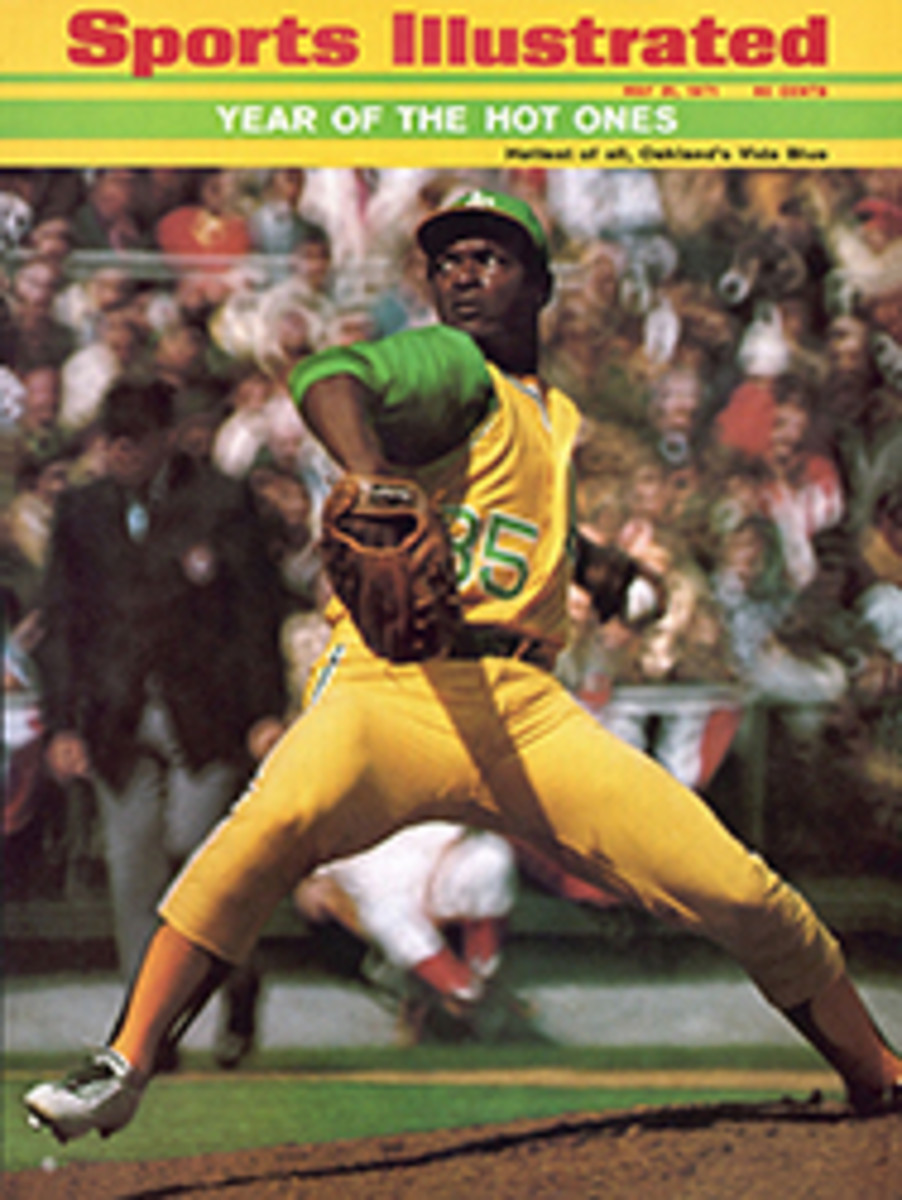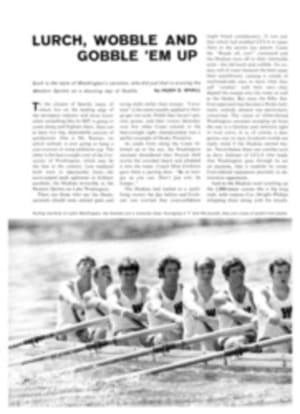
A dropout with a big future
Now that it is all over, Burt Hooton can look back upon his remarkable athletic career at the University of Texas with a galling sense of regret and resentment. For the past three years Hooton has been the star pitcher on the Southwest Conference championship Longhorn teams and, in all probability, the best pitcher in college baseball. However, after three straight years of representing District Six in the college World Series at Omaha, Neb., Texas was upset by little Pan American University of Edinburg, Texas in last weekend's district finals in successive 1-0 and 4-0 shutouts. But this is not the source of Hooton's sorrow. For sure, he regretted losing to such upstarts, particularly since he pitched so superbly in the 1-0 loss. He struck out 16 batters, surrendered only four base hits and allowed no earned runs. What wrecked him was a passed ball and a throwing error.
No, if Hooton had been given his way he would not have been there at all. He wanted to sign a professional baseball contract after graduation from King High School in Corpus Christi, but his father, James V. Hooton, now of Jackson, Miss., would not permit him, feeling—perhaps wisely—that young Burt would be better off at least starting college before entering the Hall of Fame. So Hooton went to Texas where in his freshman year he won 12 games, lost none, struck out 137 batters in 102 innings, recorded an earned run average of 0.88 and again said that he wanted to turn pro.
The lump in the resin bag this time was not his father but the rules. According to the present agreement between the colleges and organized baseball, once a youngster has entered school he cannot be signed until he has passed his 21st birthday. So Hooton went back to Texas as a sophomore, winning 12 games and losing one. He slipped to 11 and two as a junior this season, but both losses were by 1-0 scores and he broke his own school strikeout record in the playoff with Pan Am, the 16 giving him 153 for 97‚Öì innings, slightly better than 1½ per inning. More important, he celebrated his 21st birthday.
Hooton is now eligible for the baseball draft and he should be selected early. Then, after proper negotiation, he should at last sign for the bundle he has been waiting for. He even could be on a big-league roster before the year is out, for Hooton has been tailed by major league scouts since high school. "Even if you don't actually know them," he says, "you can sense their presence."
He certainly has what the scouts are after—a hopping fastball, a developing slider and "the thang," a knuckle curve ball that drops sharply in directions that sometimes surprise Hooton himself. Combine these with intelligence, excellent control (he has averaged only 27 walks a season) and size (6'1", 195 pounds) and you have the basic dream pitcher. Yet Hooton seems to regard himself as an incipient has-been.
"I've had to wait around," he says with resignation. "I've been in the same type of competition for three years. If I'd been able to sign after my freshman year I might possibly have had two years of major league ball by now. College ball is no big thing. Look, everybody on campus knows who Steve Worster is. Maybe one-third of the students know who I am. People in my position can't realize the true value of a college education. Oh, I've learned a lot since I've been here and I intend to go on for my degree in business. In fact, college baseball is great for a lot of people, but for some of us there ought to be a way out. I don't like the rules that have kept me playing here."
Hooton is no ingrate. He is just mature enough to know who he is. Certainly he has given his team maximum effort. His coach, Cliff Gustafson, a proud Texas graduate, calls him "a true All-America, the kind we oldtimers [he's 40] can appreciate." Hooton is, nevertheless, a star in a sport that rewards ability only at the major league level, and as such is an excellent example of college baseball's dilemma. The coaches, understandably, want to keep their top players in school as long as possible, thus the détente with the professionals. But the players get little recognition to compensate them for the money slipping by. Hooton only winces when the name of a contemporary like Vida Blue is mentioned.
In another sense, college baseball may be the last refuge of the student athlete. Since the star has little to gain, he leaves it as quickly as possible. Few of the major league prospects play into their senior year and starless teams like Texas' conqueror, little old Pan American, might be better off.
Pan American is deep in southern Texas, in an area populated largely by Mexican-Americans and Midwestern transplants. It has no football team and its basketball team is not much. But under Coach Al Ogletree, a minor league dropout and Texas A&M graduate, it has become a baseball school. Pan Am has only one player who might reasonably be coveted by the professionals, 22-year-old senior Centerfielder James Tyrone, and he was passed over in last year's draft. Ten of Ogletree's 25 players are seniors, 12 are married, 14 are junior college transfers, 10 are Latins, three (including Tyrone and his younger brother, Wayne) are black and 19 are from the South Texas area. Texas, by contrast, has only one junior college transfer, four Latins, one married player and no blacks.
Until this year Pan Am was a David consistently punched out by Goliath. Twice, in 1968 and last year, its teams had tried and failed to get past Texas in the district finals and move on to the college World Series. Last year Hooton beat the Broncs twice, shutting them out on two hits in the first game and finishing them off in relief in the second. Hooton also shut them out in a regular-season game this year. But Pan Am won the other three games in that series. Texas Coach Gustafson dismissed those early-season losses as nothing more than warmups for the more significant Southwest Conference schedule. Pan Am gloried in the victories.
Both teams subsequently had lovely seasons. Texas took its third straight undisputed conference championship, winning 25 of its last 28 games and finishing with a record of 33-9. Pan Am won 40, lost seven and in one stretch shut out seven consecutive opponents. Texas had a team batting average of .320 and broke school records for runs, hits and doubles. Led by James Tyrone with 49, Pan Am had 101 stolen bases. Both teams, by a happy irony, were tied for fourth in the final regular-season Collegiate Baseball rankings. In the past, Southwest Conference winners (usually Texas) represented District Six in Omaha, but in recent years as many as four teams have competed for the distinction. This year only Texas and Pan American were judged worthy by district officials. This set up some predictable bickering over the playoff series site. Texas does not like playing in Edinburg, where the fans are hostile and even the umpires sometimes so. Pan Am deeply resents playing at Texas' home field, where it had twice previously lost playoff series and where the 300-foot foul line in right field is so convenient for the left-handed hitting power of Texas.
San Antonio's windy V.J. Keefe Field, home of the Dixie Association's San Antonio Missions and the St. Mary's University Rattlers, was finally selected as a neutral site. In many ways besides neutrality, San Antonio was an ideal place for the game. It is 80 miles southwest of Austin and about 200 miles north of Edinburg. Texas' Gustafson had coached high school baseball there for 13 years (he had seven state champions at South San Antonio High); Pan Am's Ogletree was born there, both teams had players from there and there were enough University of Texas partisans around to balance the cheering of native Mexican-Americans who were Pan American fans.
There were, however, some drawbacks. Park officials overestimated Keefe Field's seating capacity by a thousand, so many of the 4,500 who bought tickets in advance for the opening game found themselves occupying standing room. Another 1,500 ticket purchasers, with no hope of sitting down, simply overran the foul territory in left and right fields. Others, who did not bother to buy tickets, watched the opening game—and a middle-inning fire in a recreation field behind them—from atop the left-field fence. The wind, blowing in gusts up to 25 miles an hour toward home plate, proved a nuisance to fans and a detriment to Texas power. Pan Am, which depends upon pitching depth and a tight defense, had the advantage. But Texas had Hooton.
The first game was obviously the key to the best two-out-of-three series. If Pan Am, which had never beaten Hooton, could somehow get by him, it had an excellent chance to throttle Texas in the second game with its superior second-line pitching. But Hooton could demoralize Pan Am and open the way for Texas power the next day.
Under Keefe Field's dim lights, a magnificent pitching duel between Hooton and Pan Am's clever Lupe Salinas resolved the issue. Salinas, who also had an 11-1 record for the regular season, gave up only five singles while striking out seven. But Hooton was overpowering. He struck out the side in the third, fifth and eighth innings. In the eighth, in fact, he struck out four men because Pan Am's Mike Duffey gained first on a third-strike passed ball.
But Hooton was also unlucky. In the second inning, Pan Am's Al Pierce singled to right field with one out and advanced to second on a passed ball. With two outs, left-handed-hitting Catcher Bill Chandler sent a sharp ground ball between first and second which Texas' First Baseman John Langerhans fielded nicely but threw low and wide toward Pitcher Hooton, who was covering first base. The ball bounced crazily away from him and Pierce lumbered all the way home from second base with the only run of the game. After Pan Am coasted to its more leisurely win on Saturday, Hooton was through as a collegian.
"Did you mind losing?" he was asked afterward.
"No," he said, setting aside a hot-fudge sundae, "losses don't bother me. You gotta get used to them somewhere."
For Burt Hooton, somewhere could soon be the big leagues.
PHOTO
HOOTON'S CAREER ENDED ON DEFEAT BEAT

